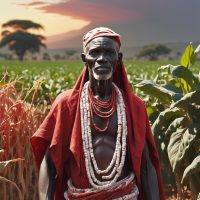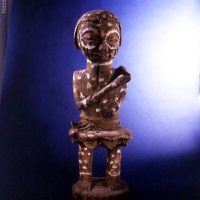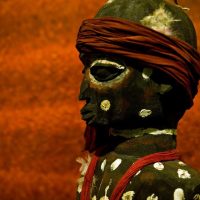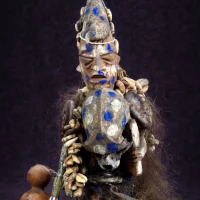Pukkeenegak : Goddess of Childbirth
Listen
At a glance
| Description | |
|---|---|
| Origin | Inuit Mythology |
| Classification | Gods |
| Family Members | N/A |
| Region | Canada, Greenland |
| Associated With | Children, Pregnancy, Childbirth |
Pukkeenegak
Introduction
Pukkeenegak is a captivating and enigmatic figure within Inuit mythology, renowned for intriguing physical traits, familial connections, and formidable powers. In Arctic regions where Inuit stories flourish, Pukkeenegak’s presence resonates through tales that blur the boundaries between human and supernatural realms. In the vast Arctic landscape, Inuit culture has cultivated a rich tapestry of myths and legends, with Pukkeenegak emerging as a prominent deity embodying life, community, and domesticity. Revered as the goddess of children, pregnancy, childbirth, and clothing-making, Pukkeenegak holds a central place in Inuit society, shaping traditions and household practices.
Physical Traits
Pukkeenegak holds a revered position in Inuit mythology, embodying the roles of goddess of children, pregnancy, childbirth, and clothing-making. Within Inuit society, she is regarded as a benevolent figure deeply integrated into traditions surrounding family and household duties. Despite limited depictions, Pukkeenegak’s presence is preserved primarily through oral traditions and generational stories. Common descriptions portray her as a gentle woman adorned with intricate facial tattoos, symbolizing social status and spiritual depth. Her representation often includes tall boots, reflecting practicality in navigating the Arctic landscape. These elements collectively emphasize Pukkeenegak’s significance and enduring influence within Inuit culture.
Family
In Inuit mythology, Pukkeenegak’s association with childbirth and family life as the goddess of children and pregnancy suggests a profound connection with families and motherhood. Despite limited details about her family background, Pukkeenegak is often perceived as a nurturing and protective figure—a universal mother to the Inuit people. This portrayal underscores her significant role in fostering community bonds and safeguarding familial well-being within Inuit society.
Other names
Pukkeenegak is predominantly known by her name across various Inuit communities, without widely recognized alternative names in Inuit mythology. However, her name can exhibit variations depending on specific Inuit dialects, such as Pukainaq, Pogeetanik, and Pudla. These variations reflect the diverse cultural landscape within Inuit communities, illustrating the intricacies of their belief systems and linguistic traditions.
Powers and Abilities
Pukkeenegak, revered as the goddess of children and pregnancy in Inuit mythology, holds profound significance in overseeing the well-being of women and children within the community. As a protector of fertility and childbirth, Pukkeenegak ensures safe deliveries and is invoked by women seeking to conceive. Her presence is deeply intertwined with the intimate and essential aspects of family life, embodying the nurturing and protective qualities associated with motherhood.
Beyond her role in childbirth, Pukkeenegak is celebrated as a patroness of domestic arts and crafts, crucial for survival in the harsh Arctic environment. Seamstresses and craftsmen look to her for inspiration and guidance in creating clothing and tools necessary for daily life. Pukkeenegak’s influence extends to fostering creativity and skill in these essential trades, reinforcing her connection to the practical needs of the community and the preservation of cultural traditions.
As a symbol of community and kinship, Pukkeenegak embodies the cooperative spirit of Inuit society. She fosters harmony among families and communities, emphasizing the importance of social cohesion and mutual support. Pukkeenegak is viewed not only as a guardian of individual families but also as a protector of traditions that strengthen the bonds within the community. Additionally, her role in ensuring the availability of vital resources like animal skins and furs underscores her significance in sustaining the material well-being of the community through hunting and gathering activities.
In summary, Pukkeenegak’s multifaceted powers and responsibilities highlight her integral role in nurturing and sustaining Inuit life. From safeguarding childbirth to inspiring craftsmanship and fostering community harmony, Pukkeenegak embodies the core values and practical necessities that define Inuit culture. Her presence resonates through the daily lives of the people, guiding them through the challenges of the Arctic environment while reinforcing the importance of family, creativity, and collective well-being.
Modern Day Influence
Pukkeenegak’s influence is deeply interwoven into the fabric of daily life within Inuit society, fostering unity and collaboration among community members. From the intricate tasks of sewing to communal activities such as cooking and gathering, Pukkeenegak’s presence underscores the interconnectedness and mutual support that define Inuit communal living.
A central aspect of Pukkeenegak’s role is her guardianship and guidance for pregnant women. As the goddess of children and pregnancy, she provides comfort and assurance to expectant mothers, ensuring their well-being and the safe arrival of newborns. Pukkeenegak’s nurturing presence highlights the sacredness of childbirth and emphasizes the pivotal role of maternal care within Inuit culture.
Inuit communities come together in celebration to honor Pukkeenegak through festivals and special events dedicated to her benevolent influence. These joyful occasions serve as important opportunities for reflection, gratitude, and collective merriment, uniting individuals in homage to the goddess of children and clothing. Through ceremonial rituals and communal gatherings, Pukkeenegak’s enduring impact is acknowledged and cherished, reaffirming her profound cultural significance and preserving her legacy for future generations.
Related Images
Frequently Asked Questions
What is lorem Ipsum?
I am text block. Click edit button to change this text. Lorem ipsum dolor sit amet, consectetur adipiscing elit. Ut elit tellus, luctus nec ullamcorper mattis, pulvinar dapibus leo.
What is lorem Ipsum?
I am text block. Click edit button to change this text. Lorem ipsum dolor sit amet, consectetur adipiscing elit. Ut elit tellus, luctus nec ullamcorper mattis, pulvinar dapibus leo.
What is lorem Ipsum?
I am text block. Click edit button to change this text. Lorem ipsum dolor sit amet, consectetur adipiscing elit. Ut elit tellus, luctus nec ullamcorper mattis, pulvinar dapibus leo.
What is lorem Ipsum?
I am text block. Click edit button to change this text. Lorem ipsum dolor sit amet, consectetur adipiscing elit. Ut elit tellus, luctus nec ullamcorper mattis, pulvinar dapibus leo.
What is lorem Ipsum?
I am text block. Click edit button to change this text. Lorem ipsum dolor sit amet, consectetur adipiscing elit. Ut elit tellus, luctus nec ullamcorper mattis, pulvinar dapibus leo.











